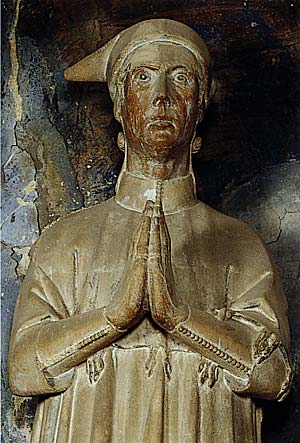
 |
| Enrico Scrovegni commissioned the building of the Chapel in Padua |
When he succeeded his father as head of the family, Enrico Scrovegni
inherited an immense fortune but along with it an extremely bad reputation.
He was conscious of his imposing pedestal of wealth that distinguished
him from the mass of tradesmen and shopkeepers but he felt the weight
of a society that openly accused him of usury. Enrico's first wife was
a daughter of Uberto il Grande of Carrara.
There is also evidence that he was a vassal of the Estensi family, since
his second wife was a member of that noble family, the most aristocratic
in north-eastern Italy. The marriage was also the fruit of capital placed
at the disposition of the Estensi princes.
A series of parchments dating from 1290, point to the formation of a conspicuous
financial fund fed by the wealth of numerous family members, women included,
in the manner of the contemporary Tuscan companies or "banks",
which fund still functioned even after the Enrico was exiled to Venice
while a part of the family remained in Padua. Enrico had already been
required to invest in the profitable Venetian emporium a part of the money
he managed together with his relatives. In fact, in 1312, one of his ships
laden with wool, cotton and cheese was sequestered by the customs officials
of Mestre.
An accounts registry from the last years of his life shows unmistakably
that Enrico invested in the Venetian market "ad negotiandum"
or "in merchanciam" or "ad cameram de frumento somme proprie"
and that these sums had been sent from Padua by priests (Rainerio and
Angelino) of the Arena Chapel.
Among his habitual creditors were members of illustrious families, the
administrators of Venice and also some Florentines. Therefore, a series
of elements proves that the penetration of the Scrovegni into Venice was
the cause of the request submitted to the doge for possession of some
of the relics of Saint Mark obviously came from a person who knew he could
claim (a) credit even with the public authorities of the Serenissima.
In any case, numerous elements indicate that the interested party was
a wheeler-dealer ready to make his immense capital bear fruit in the most
advantageous manner and that he, like his father, went beyond Veneto,
even as far as the Roman Curia. We cannot put too much faith in a report
transmitted by a rather untrustworthy source, that he hosted the future
Pope Benedict XI when he was still a cardinal, regaling him with abundant
gifts. However, it is certain that, at the time of the construction of
the Arena Chapel, a document by the same pope qualifies Enrico as a "familiaris
noster", intimating a close relationship with the pontiff dating
back to their time together in Treviso.
There also exists a more credible version of the report by Da Nono, based
on indiscretions - and backed up by documents - in which Enrico actually
deceived the same pope, letting him believe that he had extracted from
his own pocket the money necessary to build and adorn the holy edifice,
while actually using money from a nobleman politically exiled from Mantova
in 1299, one Bardellone Bonacolsi ("de bonis nobilis militis Bardolonis
de Bonacolsis, condam domini civitatis Mantue, qui per Botesellam fratrem
suum fuit expulsus"), which he probably received as some sort of
deposit. Enrico wrote his testament in 1336 in Venice, where he lived
after being exiled.